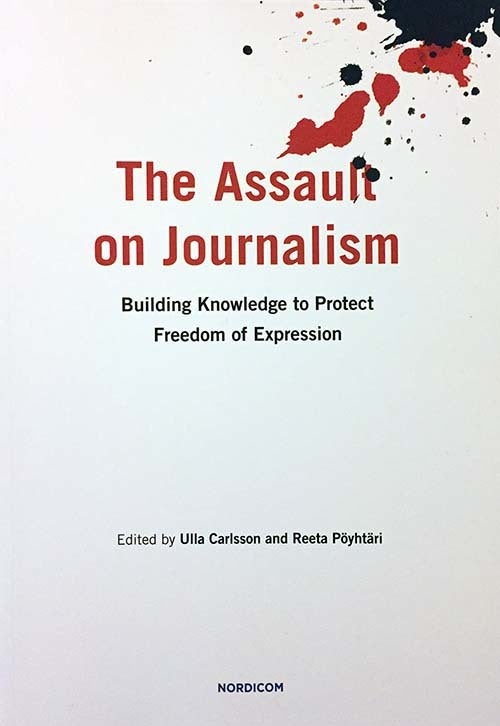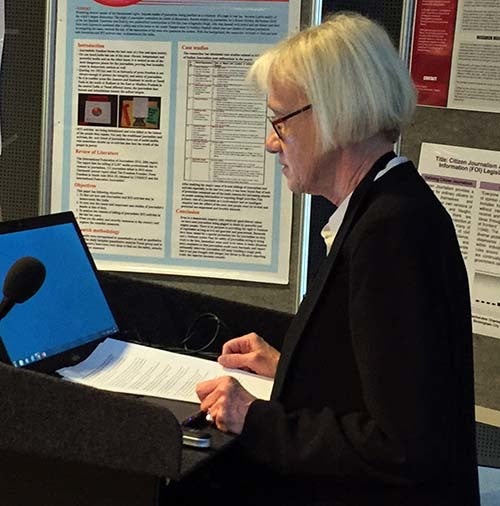The following is a chapter I wrote in “The Assault on Journalism: Building Knowledge to Protect Freedom of Expression,” edited by Ulla Carlsson and Reeta Pöyhtäri and recently published by Nordicom at the University of Gothenburg in Sweden. It was based on an urgent call I made at the 2016 UNESCO World Press Freedom Day conference in Helsinki, Finland.

The Assault on Journalism Cover (Abu-Fadil)
Journalism Schools Must Include Safety Courses in Curricula
Too many journalists are victims of violence and impunity, and more should be done in academia to prepare media students for the perils they are likely to face.
I urge all faculty members at this conference to incorporate a course on safety for journalists in their curricula. It’s not a luxury; it’s an urgent necessity.
According to the United Nations Educational, Scientific and Cultural Organization (UNESCO), one journalist is killed every five days in the line of duty and the impunity of such acts is unabated.
Unlike the issues of journalism and freedom of expression, journalists’ safety has not been a popular topic of academic research. It has rarely been discussed as a specific research question, much less in practical courses.
I participated in another session on new frontiers in disinformation and the use of propaganda, also a threat to journalists’ safety.
Panelists discussed various aspects of media’s misleading messages, hate speech, phony photographs and visuals, manipulation by terrorist groups, and the proliferation of news websites as a counterforce to government-controlled media and corporate monopolies.
The issue of journalists’ safety was very much part of that discussion, as was my insistence that it should be taught at universities to make sure students understand what awaits them.
It began in Amman
One way of mitigating risks to journalists is by introducing safety courses in the curricula of university media programs. Short workshops for professionals are not enough.
War correspondents and freelancers are among the scores of journalists worldwide who risk life and limb every day to tell stories of conflicts and relay images of humanity’s miseries, often without any protection.
I was in Amman, Jordan, in January 2015 working with UNESCO and the International Federation of Journalists (IFJ) to train journalism and media academics – deans and faculty members – from Lebanon, Palestine, Jordan and Iraq.
The faculty from Lebanon represented the Lebanese University, the American University of Science and Technology, and Holy Spirit University; from Palestine there were professors from Birzeit University, Al Quds University, and An-Najah National University; and from Iraq there were professors from the Faculty of Information at Al Iraqia University in Baghdad, and the Faculty of Information at Salahuddin University in Erbil.
The aim was to introduce safety for journalists as a required course in their respective curricula. If taught in its entirety, the course would span 12 weeks over an academic semester.
UNESCO and IFJ have been active in promoting the topic and have published guidebooks on how journalists can protect themselves in various scenarios. The two-and-a-half-day workshop was a team effort including Australian journalist, trainer and safety expert Clare Arthurs.
We asked the participants what their interests and priorities were, and presented them with a draft curriculum, draft lesson plans, and methods to benchmark and assess the material.
While several of the ’trainees’ acknowledged the need for safety awareness, most were still wedded to traditional teaching methods, giving more weight to theory than practice.
This is a problem universities face region-wide in the Arab World, as untold numbers of academics teaching journalism courses have never worked in newsrooms, in the field, or faced the types of threats and dangers that are par for the course.
Arthurs’ journalism-cum-academic background and mine added weight to the argument. Having worked on media curricula at academic institutions in a previous incarnation, I knew full well what overhauling a program and introducing new courses entailed.
There are endless committee meetings frequently involving faculty members who know nothing about the subject and who hail from different disciplines.
There are ego trippers in the staid halls of academe, turf wars, a snail-paced bureaucracy, and those who fear a new course may knock an existing one off the curriculum.
There’s also the matter of a university’s accreditation and whether such an offering would lessen the curriculum’s value.
But the subject matter is not limited to conflict zones, wars and terrorism. There are natural disasters, epidemics, and other events that put journalists’ lives in danger, and they’re being given short shrift.
Our team of trainers was reinforced by Adrien Collin from IFJ, George Awad from UNESCO, and others with field experience.
We focused on the need to include units on planning, risk assessment, personal safety, operational self-sufficiency, travel security, transport, first aid to handle a number of emergencies in the field, health care in hostile environments, demonstrations (and riots), natural disasters, outbreaks of disease, ballistics, kidnapping, women’s safety (given the large number of women journalists in the line of fire), digital security, international humanitarian law, local laws, ethics, and safe investigative reporting.
Workshop discussions centered on how many weeks were in a semester, and that varied by institution, depending on whether they were state-run or private universities. There was the issue of the language of instruction.
Most taught in Arabic, but some taught in English and others in French, depending on the country, although in the Arab world, it is not unusual to have trilingual educators, students and journalists.
One critical issue was who would teach such a course. The trainers felt strongly that a practicing journalist with teaching/training experience was best fit for the assignment.
The course is tailored to the needs of various educational systems, contexts and languages in the region, and can be adopted worldwide. It is to be made available online for easy access to all those interested in helping safeguard journalists.

Prof. Ulla Carlson (Abu-Fadil)
Progress in Beirut
Academics, media professionals and experts met in Beirut in February 2016 to push for the course.
The conference there was a follow-up of the 2015 launch and grouped Egyptian academics from Cairo University, the American University in Cairo; from Iraq’s Salahuddin University in Erbil; from Jordan’s Petra and Philadelphia Universities; from Morocco’s Institut Supérieur de l’Information et de la Communication; from Oman’s Sultan Qabous University; from Palestine’s Birzeit and Al Quds Universities; from Syria’s Yarmouk and Damascus Universities; from Tunisia’s Sfax University and the Institut de Presse et des Sciences de L’Information; from Lebanon’s Lebanese University, Holy Spirit University, Lebanese International University, and Rafic Hariri University.
By then, Michael Foley from the School of Media at the Dublin Institute of Technology had come on board to help shape the course that was written in English and Arabic.
“Students of journalism must understand the risks they confront when they work,” noted then IFJ President Jim Boumelha at the opening.
The IFJ produces an annual report of media casualties, added Boumelha, saying most of those targeted are local journalist whose names get tepid reactions and do not resonate in the media, unlike the spotlight shed on foreign correspondents.
The academics went over a draft of the course to be offered as one required uninterrupted 12-week unit, as an elective course or one from which they can select components to incorporate into other relevant media courses.
Speakers included a security expert as well as four noted Lebanese journalists – two who work locally and two whose international track record in covering conflict zones is legend.
“News organizations should train journalists and insist on safety measures and the use of proper equipment,” said Yazbeck Wehbe, a veteran of Lebanon’s LBCI TV News who also teaches journalism at several Lebanese universities.
Patrick Baz, a world-renowned photojournalist whose career is linked to Agence France-Presse (AFP), offered valuable insights on how he covered some of the hottest spots in the Arab world and what lingering impact it has had on him.
“Being a correspondent is going to places, and bearing witness to war crimes,” said Samia Nakhoul, a Reuters veteran and Middle East editor who was seriously injured and almost died when U.S. tanks lobbed shells into the Palestine Hotel in Baghdad where foreign media were based during the 2003 invasion of Iraq.
News organizations should provide trauma counseling as well as safety training, while universities should equip their students with the requisite knowledge and skills to face all manner of hazards, Nakhoul said.
The “Model Course on Safety of Journalists” on which I worked is now in print in English and Arabic and will soon be online on the UNESCO and IFJ websites.
